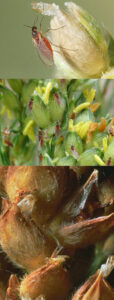 Sorghum fields range from V5 to bloom. Fields that are blooming are in the damage window for sorghum midge.
Sorghum fields range from V5 to bloom. Fields that are blooming are in the damage window for sorghum midge.
MANAGING INSECT AND MITE PESTS OF TEXAS SORGHUM ENTO-PU-170
The sorghum midge is one of the most damaging insects of sorghum in Texas, especially in the eastern half of the state. The adult sorghum midge is a small, fragile-looking, orange-red fly with a yellow head, brown antennae and legs, and gray, membranous wings.
During the single day of adult life, each female lays about 50 yellow-white eggs in the flowering spikelets of sorghum. The eggs hatch in 2 to 3 days. At first, the larvae are colorless. When fully grown, the larvae are dark orange. They complete development in 9 to 11 days and pupate between the spikelet glumes. Shortly before the adult emerges, the pupa moves toward the upper tip of the spikelet. After the adult emerges, it leaves a clear or white pupal skin at the tip of the spikelet—a sure sign of sorghum midge damage.
Under favorable conditions, a generation is completed in 14 to 16 days, and midge numbers increase during the season with each subsequent generation. Thus, late-planted sorghum is at risk to large infestation of adults moving in from fields planted earlier.
Early season infestations in sorghum are usually below damaging levels. As the season progresses, sorghum midge populations increase, especially when late planting makes flowering sorghum available in the area. Numbers often drop late in the season.
Damage: The larva damages sorghum by feeding on a newly fertilized ovary, which prevents normal kernel development. Grain loss can be extremely high. The glumes of an infested spikelet fit tightly together because no kernel develops. Typically, a sorghum grain head infested by sorghum midges has normal kernels scattered among spikelets that do not bear kernels, depending on the degree of damage.
The sorghum midge lays eggs in spikelets when yellow anthers appear on the sorghum head. An individual grain head requires 7 to 9 days to complete flowering, though it may take 2 to 3 weeks for all of the heads in a field to complete flowering. Thus, a field can remain susceptible to midge infestation for several weeks, depending on how uniformly the plants flower. Once the anthers turn reddish brown, they are no longer susceptible to midge infestation.
Scouting: Begin scouting for sorghum midges soon after head emergence, when yellow blooms first appear in the field. Scout at midmorning when the temperature rises to about 85 degrees F. The adult lives for 1 day, and each day, a new brood of adults emerge. For this reason, it is necessary to sample flowering fields almost daily.
Look for adults on the yellow blooms by carefully inspecting at close range all sides of the randomly selected flowering grain heads. The reddish, gnat-like adults crawl on or fly around the flowering heads. During inspection, handle the grain heads carefully to avoid disturbingthe adult midges.
Because they are relatively weak fliers and rely on wind currents to help them disperse, adult sorghum midges are usually most abundant along the edges of sorghum fields. For this reason, inspect plants along field borders first, particularly those downwind of earlier flowering sorghum or Johnsongrass. If the grain heads along the field edges have few or no sorghum midges, there should be little need to sample the entire field. However, if you find more than one sorghum midge per flowering grain head in a field border area, inspect the rest of the field.
The Economic Thresholds for Sorghum Midge are shown in the table below.
More on Sorghum Insect Management HERE
Crop Tour Dates:
Refugio County: June 14, 2:30 pm @ Bonnieview
Victoria County: June 20, 7:30 am @ Dacosta
Calhoun County: June 20, 2:30 pm @ Extension Office


